Main Meal for a Dinner Party
Pasto principale per una cena
MISO SOUP
ZUPPA DI MISO
Ingredienti
- 2 small carrots, cut in half moons
- 1 cup shredded cabbage
- Wakame, cut in 1 inch strips
- 1 celery stalk, minced
- 1 turnip, diced
- 8 cups (or more) spring water
- Chickpea miso (1 Tbsp or more for taste)
- Scallions, sliced
- 2 piccole carote, tagliate a metà di lune
- 1 tazza di cavolo tritato
- Wakame, tagliato a strisce da 1 pollice
- 1 gambo di sedano, tritato
- 1 rapa a dadini
- 8 tazze (o più) di acqua di sorgente
- Miso di ceci (1 cucchiaio o più per gusto)
- Scalogno, affettato
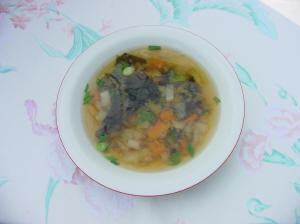
Preparazione
Put carrots, turnips and celery in water and bring to a boil, then simmer for 10 minutes. Add the rest of the ingredients, return to boil, then reduce heat and simmer for another 10 minutes. Dilute the miso with a small cup of the broth and simmer for a couple of minutes (do not boil), garnish with scallions. Serve.
Mettere le carote, le rape e il sedano in acqua e portare a ebollizione, quindi cuocere a fuoco lento per 10 minuti. Aggiungere il resto degli ingredienti, tornare ad ebollizione, quindi ridurre il calore e cuocere a fuoco lento per altri 10 minuti. Diluire il miso con una piccola tazza di brodo e fare sobbollire per un paio di minuti (non bollire), guarnire con scalogno. Servire.
RICE BAKED BALLS (WITH CABBAGE, SQUASH AND DAIKON)
PALLA DI RISO (CON CAVOLO, ZUCCHINO E DAIKON)
Rosanna learned this during her trip to Japan for Ohsawa’s centennial festival
Rosanna l'ha imparato durante il suo viaggio in Giappone per il centenario festival di Oshawa
Ingredienti
- 3 cups short-grain brown rice
- ½ of a small cabbage, cut in big chunks
- 1 small daikon, cut into big chunks
- 1 cup butternut (or buttercup) squash
- Sea salt, about half a teaspoon or less
- 6 cups water
- 1 or 2 cups whole wheat or spelt flour
- 3 tazze di riso integrale a grana corta
- ½ di un cavolo piccolo, tagliato a pezzi grandi
- 1 piccolo daikon, tagliato a pezzi grandi
- 1 tazza di zucca (o ranuncolo)
- Sale marino, circa mezzo cucchiaino o meno
- 6 tazze d'acqua
- 1 o 2 tazze di farina integrale o di farro
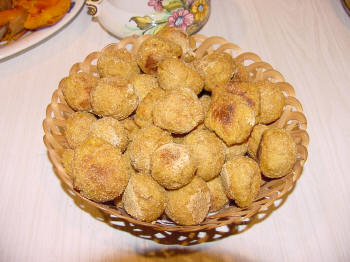
Preparazione
Wash and strain rice. Layer vegetables in a pressure cooker, add rice on top and pour water in a circular fashion around the walls of the pot so the vegetables are not disturbed. Add salt, seal and bring to pressure. Lower heat and add flame deflector to prevent burning, cook for 45 minutes. The dish can be consumed this way and it is delicious. To make the bread, as you see in the picture, turn the cooked ingredients into a food processor and puree. Then refrigerate for more than 24 hours (minimum 30 hours). Oil and flour a baking sheet and preheat oven to 400° Fahrenheit. Just before cooking, take the mixture from the refrigerator and add enough flour so the consistency is like a dough and can be scooped with a small ice cream (yuk!) scooper. Put balls on sheet allowing room for them to rise a little and cook for 20 to 30 minutes, until they look golden and delicious as in the photo. Serve cold or hot.
Lavare e filtrare il riso. Mettete le verdure in una pentola a pressione, aggiungete il riso sopra e versate l'acqua in modo circolare attorno alle pareti della pentola in modo che le verdure non siano disturbate. Aggiungi sale, sigilla e porta a pressione. Abbassare il calore e aggiungere un deflettore per evitare di bruciare, cuocere per 45 minuti. Il piatto può essere consumato in questo modo ed è delizioso. Per fare il pane, come vedi nella foto, trasforma gli ingredienti cotti in un robot da cucina e purea. Quindi conservare in frigorifero per più di 24 ore (minimo 30 ore). Olio e farina una teglia e preriscaldare il forno a 400 ° Fahrenheit. Poco prima di cuocerlo, prendi il composto dal frigorifero e aggiungi abbastanza farina in modo che la consistenza sia come un impasto e possa essere raccolto con un piccolo gelato (yuk!) Scooper. Metti le palline sul foglio lasciando spazio per farle crescere un po 'e cuocere per 20 o 30 minuti, finché non sembrano dorate e deliziose come nella foto. Servire freddo o caldo.
TEMPEH WITH OYSTER MUSHROOMS
TEMPEH CON FUNGHI OYSTER
One of James’ favorites
Uno dei preferiti di James
Ingredienti
- 1 pound tempeh (Rosanna likes the kind with sea vegetables mixed in)
- 1 medium onion, cut in thin half-moons
- 2 cups sliced oyster mushrooms
- 2 or 3 cups water or vegetable stock
(from making boiled salad) - 2 tsp barley miso
- 1 tsp mustard
- ¼ tsp rosemary, chopped
- ½ tsp thyme
- ½ tsp marjoram
- 2 Tbsp kudzu
- Sesame seed oil for frying
- 1 pound tempeh (Rosanna ama il tipo con verdure di mare mescolate)
- 1 cipolla media, tagliata in mezzelune sottili
- 2 tazze di ostriche ai funghi
- 2 o 3 tazze di acqua o brodo vegetale (dal fare insalata bollita)
- 2 cucchiaini di miso d'orzo
- 1 cucchiaino di senape
- ¼ di cucchiaino di rosmarino, tritato
- ½ cucchiaino di timo
- ½ cucchiaino di maggiorana
- 2 cucchiai di kudzu
- Olio di semi di sesamo per friggere
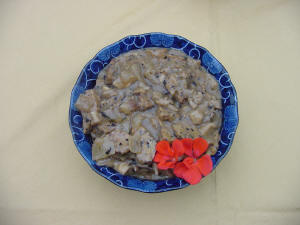
Preparazione
Cut tempeh into little squares or triangles. Heat oil and fry tempeh until it is golden. Drain on paper towels. In a saucepan, fry onions in a little oil. Then add tempeh, water or stock, and seasoning. Bring to a boil and simmer for 20 minutes. Add mushroom and cook for another 5 minutes. Then add diluted miso, melt kudzu with a few tablespoons of cold water and pour in, mixing well. Cook for a few more minutes and serve.
Tagliare tempeh in piccoli quadrati o triangoli. Scalda l'olio e friggi tempeh finché è dorato. Scolare su asciugamani di carta. In una casseruola, soffriggere le cipolle in poco olio. Quindi aggiungere tempeh, acqua o brodo e condimento. Portare a ebollizione e cuocere a fuoco lento per 20 minuti. Aggiungere il fungo e cuocere per altri 5 minuti. Quindi aggiungere il miso diluito, sciogliere il kudzu con qualche cucchiaio di acqua fredda e versare, mescolando bene. Cuocere per qualche altro minuto e servire.
PRESSED SALAD
INSALATA PRESSATA
Ingredienti
- 2 Celery stalks
- ½ head (or less) romaine lettuce
- White center leaves of the head of the escarole
- 5 radishes with leaves
- ½ bulb of fennel
- Sea salt
- Umeboshi vinegar
- 2 gambi di sedano
- ½ testa (o meno) lattuga romana
- Foglie centrali bianche della testa della scarola
- 5 ravanelli con foglie
- ½ bulbo di finocchio
- Sale marino
- Aceto Umeboshi
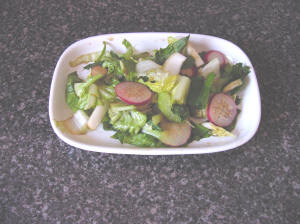
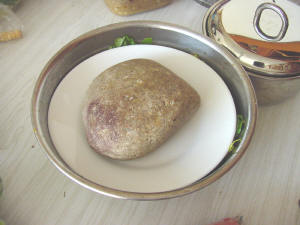
Preparazione
Wash all vegetables, using plenty of water, then drain. Diagonally cut the celery into thin slices. Tear romaine leaves into small pieces. Chop the escarole into one inch pieces. Cut radishes in thin rounds. Chop the radish leaves, about in half. Chop the fennel into strips. Combine and toss all ingredients together, adding about 3 tsp sea salt. Press (Rosanna uses a bowl, plate and stone as in the picture at left) for one hour. Wash out salt and strain out excess water. Add a few drops of umeboshi vinegar and serve.
Lavare tutte le verdure, usando molta acqua, quindi scolare. Tagliare diagonalmente il sedano a fette sottili. Lacrima di romaine lascia a pezzetti. Taglia la scarola in pezzi di un pollice. Tagliare i ravanelli a rondelle sottili. Tritare le foglie di ravanello, circa a metà. Tagliare il finocchio a strisce. Unire e mescolare tutti gli ingredienti insieme, aggiungendo circa 3 cucchiaini di sale marino. Premere (Rosanna usa una ciotola, un piatto e una pietra come nella foto a sinistra) per un'ora. Lavare il sale e filtrare l'acqua in eccesso. Aggiungere qualche goccia di aceto di umeboshi e servire.
NISHIME
Ingredienti
- 2″ piece kombu seaweed
- 3 turnips
- 2 medium carrots
- 1 lotus root
- ¼ head of cabbage
- 1 small cauliflower
- Shoyu (soy sauce)
- 2 pezzi di alga kombu
- 3 rape
- 2 carote medie
- 1 radice di loto
- ¼ testa di cavolo
- 1 piccolo cavolfiore
- Shoyu (salsa di soia)
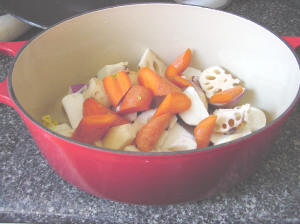
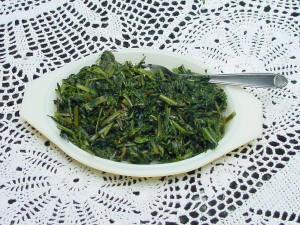
Lavare e tagliare le verdure in grandi pezzi. Metti kombu in una pentola pesante e sovrapponi le verdure. Aggiungi mezza tazza d'acqua. Coprire con un coperchio pesante e portare a ebollizione. Quando viene generata una buona quantità di vapore, abbassare la fiamma e cuocere a fuoco lento per 15 minuti. Aggiungere la salsa di soia a piacere, continuare a cuocere a fuoco lento per altri 5 minuti o finché le verdure non sono morbide.
(Note!! If you use a plain cast iron pot, omit the lotus root or all your vegetables will be darkened and become unattractive.)
(Nota! Se utilizzi un piatto in ghisa, ometti la radice di loto o tutte le verdure saranno oscurate e diventeranno poco attraenti.)
STEAMED BABY BOK CHOY
BAMBINO AL VAPORE BOK CHOY
Preparazione
Pull the bok choy apart and rinse carefully (they are always full of sand). Steam it for two minutes, add a pinch of salt or sprinkle with a little soy sauce. Serve.
Tira fuori il bok choy e sciacqua con cura (sono sempre pieni di sabbia). Cuocere a vapore per due minuti, aggiungere un pizzico di sale o cospargere con un po 'di salsa di soia. Servire.
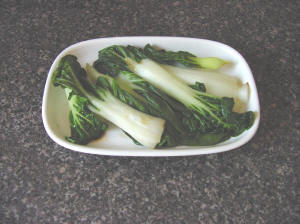
BOW TIE PASTRIES
FARINA DI LEGA DI ARIA
Ingredienti
- 1 Tbsp dry yeast
- 3 ½ cups spelt flour
- 1 ½ cups fruit juice
- ½ cup walnut oil
- 1 tsp vanilla extract
- 2 tsp cinnamon
- ½ tsp sea salt
- 1 Tbsp orange or lemon zest
- Raspberry and grape jelly (mixed)
- Pecans
- Peanut butter
- 2 to 4 tablespoons rice syrup
- 1 cucchiaio di lievito secco
- 3 cucchiaini di farina di farro
- 1 ½ bicchiere di succo di frutta
- ½ tazza di olio di noci
- 1 cucchiaino di estratto di vaniglia
- 2 cucchiaini di cannella
- ½ cucchiaino di sale marino
- 1 cucchiaio di arancia o scorza di limon
- Lampone e gelatina di uva (misto)
- Noci Pecan
- Burro di arachidi
- Da 2 a 4 cucchiai di sciroppo di riso
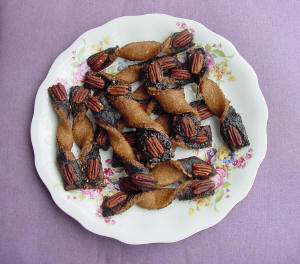
Preparazione
Dissolve yeast in a half cup of warm fruit juice and let stand 5 minutes. Add enough flour to form a thin batter and mix well. Scrape down the sides of the bowl, cover and let it rise in a warm place until it doubles in size. Beat in oil, vanilla, and rice syrup. Add the rest of the flour, cinnamon, sea salt, and zest. Knead well, adding enough fruit juice to make a sticky dough. Place in a bowl, cover and let it rise again until it doubles in size. Roll out dough in a rectangular sheet about ¼ inch thick. Cut away uneven edges and spread peanut butter and then jam on top. Then cut into strips with a rolling ravioli cutter and twist each end of the strip in the opposite direction as you see in the picture. This will form a bow, the fillings should be face-up. Place on an oiled and floured cookie sheet and let it rise again. Bake in a preheated oven at 350° Fahrenheit for 20-30 minutes. Serve your special dinner!
Sciogliere il lievito in mezzo bicchiere di succo di frutta caldo e lasciare riposare per 5 minuti. Aggiungere abbastanza farina per formare una pastella sottile e mescolare bene. Raschiare i lati della ciotola, coprire e lasciarlo lievitare in un luogo caldo fino a quando non raddoppia. Sbattere l'olio, la vaniglia e lo sciroppo di riso. Aggiungere il resto della farina, cannella, sale marino e la scorza. Impastare bene, aggiungendo abbastanza succo di frutta per fare una pasta appiccicosa. Mettilo in una ciotola, copri e lascialo rialzare finché non si raddoppia. Stendere l'impasto in una sfoglia rettangolare di circa ¼ di pollice di spessore. Tagliare i bordi irregolari e spalmare il burro di arachidi e quindi intrufolarsi sopra. Quindi tagliare a strisce con un cutter per ravioli e ruotare ogni estremità della striscia nella direzione opposta come si vede nella figura. Questo formerà un arco, i riempimenti dovrebbero essere a faccia in su. Mettilo su un foglio di biscotti oliato e infarinato e lascialo rialzare. Cuocere in forno preriscaldato a 350 ° Fahrenheit per 20-30 minuti. Servi la tua cena speciale!